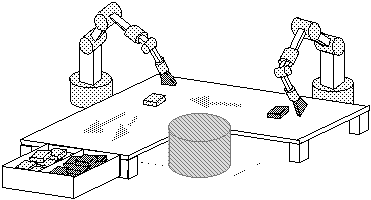
Releasing Manipulation
In this research, we proposed a novel manipulation -- Releasing Manipulation which is different from conventional manipulations, the transportation task is not carried out by "Pick and Place", but by smoothly accelerating and releasing the object. In other words, the manipulator gives the object initial translational and rotational velocities to make the object slide on a surface by its inertia under the action of friction. Obviously, this kind of manipulation possesses advantages such as wide reachable range of an object and simple mechanism of a robot hand. We have obtained some important and useful results from our earlier research. To further illustrate this kind of manipulation, we did some work as follows: (1). Established an experiment system: manipulators are controlled by personal computers, the final configuration (the translated displacement and rotated angles) of object is measured by a CCD camera. To get the above configuration values precisely, based on the principle of perspective view transformation and the concept of cross-ratio, a simple but effectual method for calibrating the measuring system is proposed. This method has been used in our experiment successfully. (2). With different shape of objects and different initial velocities, the relationship between the final configuration and the initial velocities is investigated, further, the relationship between the velocities of object and the hitting velocities and position of manipulator is also examined. The results from experiments are compared with the theoretical results and the error casues are pointed out. A method to obtain the initial hitting velocities and position of the manipulator is presented. (3). A learning algorithm is introduced to auto-modify the robot commands in order to decrease the affections of uncertainties such as the smoothness of surface and others, and to improve the positional precision of object. (4). Further, to improve the pose precision of object or to avoid the obstacle, the impact with environment or the impact between robot hands is actively used. (5). By utilizing the collision with a wall, the precision of object is improved; moreover, with a hand of parabola shape, the impact between robot hand and object is vanished. This manipulation is illustrated with a series of experiments.
Keywords: Releasing Manipulation, Friction, Impact, Initial Velocity, Learning Control
References

Fig.1 A Example of Releasing Manipulation